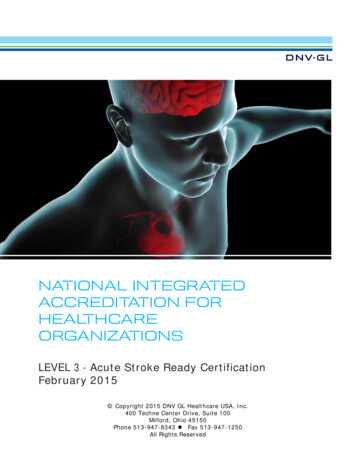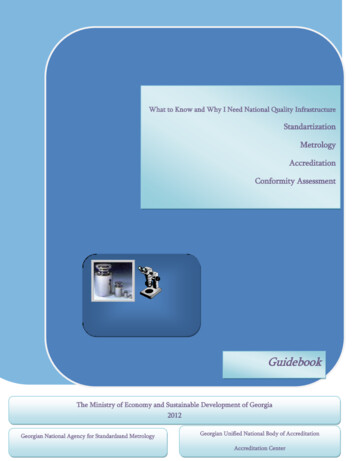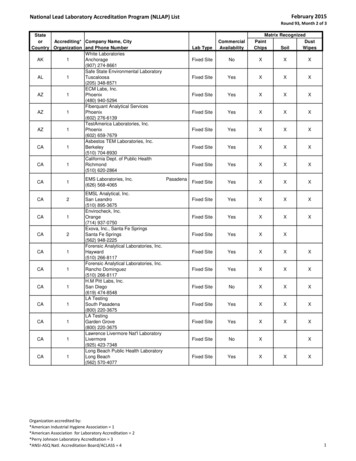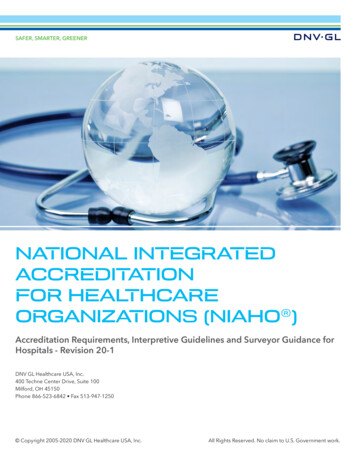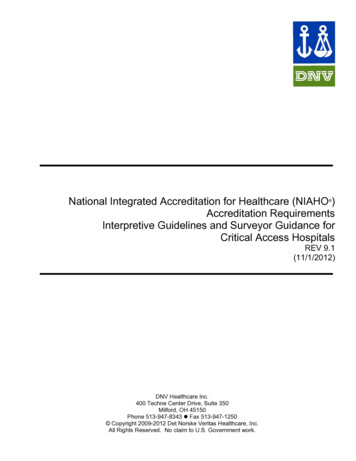
Transcription
National Integrated Accreditation for Healthcare (NIAHO )Accreditation RequirementsInterpretive Guidelines and Surveyor Guidance forCritical Access Hospitals REV 9.1(11/1/2012)DNV Healthcare Inc.400 Techne Center Drive, Suite 350Milford, OH 45150Phone 513-947-8343 Fax 513-947-1250 Copyright 2009-2012 Det Norske Veritas Healthcare, Inc.All Rights Reserved. No claim to U.S. Government work.
NIAHO Critical Access Hospitals Accreditation RequirementsInterpretive Guidelines & Surveyor GuidanceRev 9.1Table of ContentsUse of NIAHODefinitionsInterpretive Guidelines and Surveyor GuidancePAGE67QUALITY MANAGEMENT SYSTEM (QM)QM.1Quality Management SystemQM.2ISO 9001 Quality Management SystemQM.3Quality OutlineQM.4Management RepresentativeQM.5Documentation and Management ReviewsQM.6System RequirementsQM.7Measurement, Monitoring, AnalysisQM.8Patient Safety System9910111112121316GOVERNING BODY / CHIEF EXECUTIVE (GB)GB.1Legal ResponsibilityGB.2DisclosureGB.3Institutional Plan and BudgetGB.4AgreementsGB.5Contracted Services171720212223MEDICAL STAFF (MS)MS.1Organized Medical StaffMS.2Accountability / ResponsibilityMS.3Physician Assistant, Nurse Practitioner, Clinical Nurse SpecialistsMS.4Medical Staff and Health Professional ParticipationMS.5Medical Staff Bylaws, Rules and RegulationsMS.6AppointmentMS.7Performance DataMS.8Continuing EducationMS.9Governing Body / Chief Executive RoleMS.10Clinical PrivilegesMS.11Temporary Clinical PrivilegesMS.12Corrective or Rehabilitative ActionMS.13Admission RequirementsMS.14Medical Record MaintenanceMS.15History and 2829303132323334353637384041NURSING SERVICES (NS)NS.1Nursing ServiceNS.2Nurse Executive / LeaderNS.3Assessment and Plan of Care42424546STAFFING MANAGEMENT (SM)SM.1Professional ScopeSM.2Determining and Modifying StaffingSM.3Job DescriptionSM.4OrientationSM.5Staff Evaluations4848494950512
NIAHO Critical Access Hospitals Accreditation RequirementsInterpretive Guidelines & Surveyor GuidanceRev 9.1SERVICE PROVISION (SP)SP.1ServicesSP.2Committee InvolvementSP.3Periodic ReviewPAGE52525253SURGICAL SERVICES (SS)4SS.1OrganizationSS.2Staffing and SupervisionSS.3Practitioner PrivilegesSS.4History and PhysicalSS.5Available EquipmentSS.6Operating Room RegisterSS.7Post-Operative CareSS.8Operative ReportSS.9Immediate Post-Operative Note54545657586161626263ANESTHESIA SERVICES (AS)AS.1OrganizationAS.2AdministrationAS.3Policies and Procedures64646670EMERGENCY SERVICES (ED)ED.1OrganizationED.2StaffingED.3Equipment, Supplies and MedicationED.4Blood and Blood ProductsED.5Emergency Response SystemsED.6Off-Campus Departments73737577797980MEDICATION MANAGEMENT (MM)MM.1Management PracticesMM.2FormularyMM.3Scheduled DrugsMM.4Medication OrdersMM.5Review of Medication OrdersMM.6OversightMM.7Available Information8080858687899193LABORATORY SERVICES (LS)LS.1Services9494MEDICAL IMAGING (MI)MI.1ServicesMI.2Radiation 6Staff95959697989899DIETARY SERVICES (DS)DS.1OrganizationDS.2Services and DietsDS.3Diet Manual99991011023
NIAHO Critical Access Hospitals Accreditation RequirementsInterpretive Guidelines & Surveyor GuidanceRev 9.1REHABILITATION SERVICES (RS)RS.1OrganizationRS.2Management and SupportRS.3Treatment PlanPAGE103103104105RESPIRATORY CARE SERVICES (RC)RC.1OrganizationRC.2Physician OrderRC.3Policies or Protocols105105106107INFECTION CONTROL (IC)IC.1Infection Control System108108DISCHARGE PLANNING (DC)DC.1Discharge Planning Evaluation113113UTILIZATION REVIEW (UR)UR.1Utilization Review Process115115PATIENT RIGHTS (PR)PR.1Specific RightsPR.2Advance DirectivePR.3Language and CommunicationPR.4Informed ConsentPR.5Grievance ProcedurePR.6Restraint or SeclusionPR.7Restraint or Seclusion: Staff Training RequirementsPR.8Restraint or Seclusion: Report of DeathPR.9Visitation Rights117117120121121122124133135136MEDICAL RECORDS SERVICE (MR)MR.1Medical Record SystemMR.2Complete Medical RecordMR.3RetentionMR.4ConfidentialityMR.5Record Content137137137138139140ORGAN, TISSUE AND EYE PROCUREMENT (TO)TO.1ProcessTO.2Organ Procurement Organization (OPO) Written AgreementTO.3Respect for Patient RightsTO.4Documentation143143143146146PHYSICAL ENVIRONMENT (PE)PE.1FacilityPE.2Life Safety ManagementPE.3Safety ManagementPE.4Security ManagementPE.5Hazardous Material (HAZMAT) ManagementPE.6Emergency ManagementPE.7Medical Equipment ManagementPE.8Utility Management1471491491521531541561581594
NIAHO Critical Access Hospitals Accreditation RequirementsInterpretive Guidelines & Surveyor GuidanceRev 9.1APPENDIX – SWING BEDS (SB-A)PAGE162ADMISSION, TRANSFER AND DISCHARGE (TD)TD.1Transfer and Discharge rientation for Transfer or DischargeTD.5Change or Room in Composite Distinct PartTD.6Discharge Summary162162163163164165165PLAN OF CARE (PC)PC.1AssessmentPC.2Care Plan166166167RESIDENT RIGHTS (RR)RR.1Exercise of RightsRR.2Notice of Rights and ServicesRR.3Health Care DecisionsRR.4Advance DirectivesRR.5Medicaid BenefitsRR.6Personal Privacy and 69169171172172173174174177FACILITY SERVICES (FS)FS.1ActivitiesFS.2Social ServicesFS.3Dental ServicesFS.4Specialized Rehabilitative Services177177178180181RESIDENT NUTRITION (RN)RN.1Nutritional Status183183APPENDIXDISTINCT PART UNIT - REHABILITATION UNIT (RU-B)185APPENDIXDISTINCT PART UNIT - PSYCHIATRIC UNIT (PU-B)1945
NIAHO Critical Access Hospitals Accreditation RequirementsInterpretive Guidelines & Surveyor GuidanceRev 9.1Use of NIAHO Interpretive Guidelines and Surveyor GuidanceEffective DateThese NIAHO Interpretive Guidelines and Surveyor Guidance for Critical Access Hospital document. Revision9.1, Effective Date: November 1, 2012National Professional Organizations- Standards of PracticeStandards of practice of the national professional organizations referenced in this NIAHO InterpretiveGuideline and Surveyor Guidance document are consultative and considered in the accreditation decision.Federal Laws, Rules and RegulationsThe most current version of Federal law and the Code of Federal Regulations referenced in this NIAHO Interpretive Guideline and Surveyor Guidance document are incorporated herein by reference and constitute NIAHO accreditation requirements.This NIAHO Accreditation Standards Interpretive Guidelines and Surveyor Guidance for Critical AccessHospitals (NIAHO CAH) document is based upon the Centers for Medicare and Medicaid (CMS) Conditions ofParticipation for Critical Access Hospitals 42 CFR 485.606 and State Operations Manual Regulations and InterpretiveGuidelines for Critical Access Hospitals. These Interpretive Guidelines also are periodically updated based on noticesdistributed from CMS. Hospitals participating in the Medicare and Medicaid program are expected to comply withcurrent Conditions of Participation. When new or revised requirements are published hospitals are expected todemonstrate compliance in a time frame consistent with the effective date published by CMS in the Federal Register.Life Safety Code The Life Safety Code of the National Fire Protection Association referenced in this NIAHO InterpretiveGuideline and Surveyor Guidance document are incorporated herein by reference and constitute NIAHO accreditationrequirements.6
NIAHO Critical Access Hospitals Accreditation RequirementsInterpretive Guidelines & Surveyor GuidanceRev 9.1DEFINITIONSAOAAmerican Osteopathic AssociationAMAAmerican Medical AssociationAORNAssociation of periOperative Registered NursesAPICAssociation of Professionals in Infection Control and EpidemiologyASAAmerican Society of AnesthesiologistsCAHCritical Access HospitalCDCCenters for Disease Control and PreventionCNSClinical Nurse SpecialistCEOChief Executive OfficerCFRCode of Federal RegulationsCMSCenters for Medicare and Medicaid ServicesCRNACertified Registered Nurse AnesthetistDEADrug Enforcement AdministrationECFMGEducational Commission for Foreign Medical GraduatesFDAFood and Drug AdministrationHHAHome Health AgencyHVACHeating Ventilating and Air ConditioningISMPInstitute for Safe Medication PracticesISOInternational Organization of StandardizationLife Safety CodeLife Safety Code of the National Fire Protection AssociationLIPLicensed Independent PractitionerNFPANational Fire Protection AssociationNLNNational League for NursingNPNurse PractitionerNPDBNational Practitioner Data BankOIGOffice of Inspector General, Department of Health and Human ServicesPAPhysician AssistantPhysicianDoctor of Medicine or OsteopathyPRN (prn)Pro re nata, as the occasion arises, when necessary7
NIAHO Critical Access Hospitals Accreditation RequirementsInterpretive Guidelines & Surveyor GuidanceRev 9.1PUPsychiatric Unit. Inpatient psychiatric services provided in a separate anddistinct part unit of the CAHQIOQuality Improvement OrganizationQMSQuality Management SystemResidentPerson receiving post-CAH SNF care in the CAHRURehabilitation Unit. Inpatient rehabilitation services provided in a separateand distinct part unit of the CAH.Rural Health NetworkAn CAH that includes at least one CAH and at least one CAH thatfurnishes acute care servicesSatellite FacilityPart of a CAH unit that provides inpatient services in a building also usedby another CAH, or in one or more entire buildings located on the samecampus as buildings used by another CAH.SecretarySecretary of the Department of Health and Human ServicesSMDASafe Medical Devices Act of 1990SNCSkilled Nursing CareSNFSkilled Nursing FacilitySRStandard Requirement. Additional explanatory information under each majoraccreditation requirement in this Guide.Direct ServicesUnless the context indicates otherwise, means servicesprovided by employed staff of the CAH, not services provided througharrangements or agreements.8
NIAHO Critical Access Hospitals Accreditation RequirementsInterpretive Guidelines & Surveyor GuidanceRev 9.1QUALITY MANAGEMENT SYSTEM (QM)QM.1 QUALITY MANAGEMENT SYSTEMThe governing body (or organized group or individual who assumes full legal authority and responsibility for operationsof the CAH), medical staff, and administrative officials are responsible and accountable for ensuring that the CAHimplements and maintains an effective quality management system. This quality management system shall ensurethat corrective and preventive actions taken by the CAH are implemented, measured and monitored.In addition to any other Quality Management System standard, the CAH is required to comply with QM.1 at all times asa part of its Quality Management System. Until the CAH achieves ISO 9001 Compliance/ Certification, theorganization shall begin implementation of the requirements at a minimum of the ISO 9001 methodology specified inQM.2, SR.3 (below).SR.1The CAH must develop, implement and maintain an ongoing Quality Management System formanaging quality, performance and patient safety. As a part of the Quality Management System the CAHmust periodically evaluate (at least once annually) the processes, functions and areas of the organization todetermine the appropriate utilization of services, ensure that polices have been followed, and necessarychanges are made when identified. The scope of this review will include, but not limited to:SR.1a Utilization of services provided by the CAH including the number of patients served and thevolume of services provided.SR.1b Review of a representative sample of both open and closed clinical records 485.641(a)(1)(ii)SR.1c Review of the CAH’s policies and procedures 485.641(a)(1)(iii), 485.641(a)(2)SR.1d When the CAH participates in a Quality Improvement Organization (QIO), the CAH mustdemonstrate that information and supporting documentation is provided to the QIO asrequired.SR.1d(1) The CAH will review and consider the findings and/or recommendations of theevaluation of the QIO and implements the appropriate corrective/preventive actionas necessary.SR.2The CAH must implement hospital-wide quality assessment and performance improvement effortsto evaluate the appropriateness of the diagnosis, treatment, outcomes, quality of care and patient safety andthat corrective and preventive actions are documented, implemented and evaluated for effectiveness. Thiswill include, but not limited to:SR.2a evaluation of all patient care services and other services provided affecting the patient healthand safety.SR.2b evaluation of nosocomial infections and medication therapySR.2c the quality and appropriateness of the diagnosis and treatment provided by nursepractitioners, clinical nurse specialists, and physician assistants and evaluated by a memberof the CAH who is a doctor or medicine or osteopathy.SR.2d the quality and appropriateness of the diagnosis and treatment provided by doctors ormedicine or osteopathy at the CAH, or in the case of distant-site physicians and practitioners providingtelemedicine services to the CAH’s patients under a written agreement between the CAH and adistant-site hospital, the distant-site hospital; or in the case of distant-site physicians and practitionersproviding telemedicine services to the CAH’s patients under a written agreement between the CAHand a distant-site telemedicine entity9
NIAHO Critical Access Hospitals Accreditation RequirementsInterpretive Guidelines & Surveyor GuidanceRev 9.1This evaluation will be conducted by at least:SR.2d(1) one hospital that is a member of the network, when applicable;SR.2d(2) one QIO or equivalent organization; orSR.2d(3) one other appropriately quality entity identified in the State rural healthcare planSR.3The organization will assure that adequate resources are allocated for measuring, assessing, improving, andsustaining the CAH's performance and reducing risk to patients.SR.4As one of the quality improvement initiatives, the CAH may develop and implement an information technologysystem explicitly designed to improve patient safety and quality of care. This project, in its initial stage ofdevelopment, does not need to demonstrate measurable improvement in indicators related to healthoutcomes.QM.2 ISO 9001 QUALITY MANAGEMENT SYSTEMSR.1.SR.2Compliance with the ISO 9001 standard must occur within three (3) years after the initial deemed NIAHO accreditation. The Organization shall either demonstrate compliance with the ISO 9001 Quality ManagementSystem principles through a NIAHO accreditation survey or maintain Certification through an AccreditedRegistrar. Only certificates covered by an accreditation by an IAF MLA (International Accreditation ForumMultilateral Recognition Agreement) signatory shall be eligible. The organization shall maintain ISO 9001compliance or formal Certification in order remain eligible for NIAHO Accreditation.An Accredited Registrar recognized by an IAF MLA (International Accreditation Forum Multilateral RecognitionAgreement) shall meet the following minimum criteria::SR.2a. shall be accredited for IAF Scope 38; and,SR.2b. must have certified or conducted a pre-assessment at a minimum of twelve (12) hospitals.SR.3The organization will initiate and continue implementation of the ISO 9001 methodology to achieve complianceor certification as stated in QM.1. The organization will initiate a process to begin the implementation toaddress:SR.3a Control of Documents: the organization’s documents (i.e. policies, procedures, forms) are structuredin a manner to ensure that only the proper revisions are available for use;SR.3b Control of Records: the organization ensures that suitable records are maintained for the CoP andNIAHO requirements;SR.3c Internal Surveys (Internal Audits) – the organization will initiate a process of conducting internalreviews of its processes, policies and procedures and prepare corrective/preventive action plans tobe implemented and a means verify such actions to be effective;SR.3d Corrective and Preventive Action: the organization will have a mechanism in place to document andmonitor corrective and preventive action implemented in some manner to address improvement andchanges, where appropriateSR.3e The organization will initiate a process to establish measurable quality objectives and periodicallyreview progress toward meeting these objectives; and10
NIAHO Critical Access Hospitals Accreditation RequirementsInterpretive Guidelines & Surveyor GuidanceRev 9.1SR.3fAppropriate information has been submitted to the oversight group for quality management as requiredin QM.6 SR.1 as well as top management for review and analysis during a management reviewprocess.Interpretive Guidelines:The ISO 9001 requirements are assessed during each survey of the CAH. The CAH has 3 years from the initialdeemed NIAHO accreditation to achieved compliance or certification to ISO 9001. If the CAH is currently certified toISO 9001, the Registrar that currently certifies the CAH must be verified using current criteria established under SR.2aand SR.2b. This should be verified prior to the CAH’s accreditation survey.The CAH shall demonstrate that aspects consistent with ISO 9001 methodologies identified in SR.3a-SR.3f (above)are present. This may not be of level of compliance with ISO 9001 but will be in place in some manner. If the surveyteam is conducting the annual ISO periodic survey during the NIAHO survey, the survey team will assess theapplicable ISO 9001 requirements and review the status of findings and corrective action(s) taken to validate that theyhave been implemented. A separate ISO 9001 report will be created to indicate any findings as a result of the ISOsurvey, when applicable.If the CAH has failed to meet the requirements within the timeframe as described above regarding ISO 9001compliance or certification, the Jeopardy Status process will be initiated.Surveyor Guidance:The lead surveyor will be provided information regarding the CAH with regard to their current compliance orcertification status to ISO 9001 prior to the accreditation survey.The lead surveyor will be required to describe the process to the senior leadership for being in compliance with orattaining certification to ISO 9001 if the CAH is not already ISO certified.If the CAH is already certified to ISO 9001 and the survey team is not conducting the periodic annual survey requiredby ISO at the time of the NIAHO survey, the lead surveyor will verify that the Registrar is an Accredited Registrar inaccordance with QM.1, SR.2.The survey team will verify that the organization has implemented mechanisms to demonstrate that similar practices inplace, consistent with ISO methodologies as listed in SR.3a – SR.3f, are present in some manner and continuedthrough the period the hospital is required to maintain compliance or certification to ISO 9001 at which time the fullscope of the ISO 9001 requirements must be met as stated within the timeframe under SR.1.QM.3 QUALITY OUTLINE/PLANThe organization shall outline the methodology, practice and related policies for addressing how quality andperformance are measured, monitored, analyzed and continually improved to improve health outcomes and reducerisks for patients.Interpretive Guidelines:The CAH will present documentation to the survey team that clearly defines how quality and performance aremeasured, monitored, analyzed and continually improved.Surveyor Guidance:The CAH can document conformance in a variety of ways. An example would include a Quality Manual orPerformance Improvement / Quality Management Plan. Verify that the CAH has clearly defined how they measurequality and performance. The monitoring methods, data analysis and effectiveness of action(s) taken will be verified.11
NIAHO Critical Access Hospitals Accreditation RequirementsInterpretive Guidelines & Surveyor GuidanceRev 9.1QM.4 MANAGEMENT REPRESENTATIVEA management representative shall be designated and shall have the responsibility and authority for ensuring that therequirements of the Quality Management System are implemented and maintained.Interpretive Guidelines:The senior leadership is required to designate an individual as a Management Representative. A requirement of ISO9001 is to define the Management Representative’s responsibilities. The Management Representative is responsibleto ensure the effectiveness of the quality management system for the CAH. This individual will ensure processes arein place for internal reviews (internal audit) and management reviews to ensure that corrective and preventiveaction(s) are carried out and are measured for effectiveness.Surveyor Guidance:Verify documentation to demonstrate that the Management Representative has been identified and there is a definedscope of responsibilities for this individual.QM.5 DOCUMENTATION AND MANAGEMENT REVIEWSAny variation, deficiency or non-conformity identified by the organization shall be addressed by the organization.Appropriate corrective or preventive action will be determined, applied, and documented in accordance with the qualitymanagement system of the organization. Documentation of activities may take the form of a Failure, Mode and EffectAnalysis, Root Cause Analysis, Performance Reports, Non-Conformity Report, specific Improvement Project analysis,etc. This documentation shall become a part of the Management Review performed at regular intervals, at a minimumof once annually. (485.641(b)(5)(i); 485.645(b)(5)(ii); 485.64(b)(5)(iii)Interpretive Guidelines:The CAH is to have identified, applied and documented nonconformity (non-compliance) throughout the CAH and thesubsequent corrective/preventive action(s) taken. The CAH can demonstrate this in various ways, but there should beinformation present that validates that the CAH has corrected the nonconformity and that the action(s) implementedhave been effective and sustained. The CAH should be able to demonstrate that planned actions were effective byquantifiable measurement subject to internal reviews (internal audits) or other means,The results of these activities are communicated to senior leadership, usually conducted as a part of managementreview.A management review is defined as a formal evaluation by top management of the status, adequacy and effectivenessof the quality management system (QMS).Surveyor Guidance:Review examples of the following: Nonconformity Report, Root Cause Analysis, Failure Mode and Effects Analysis, orother documents that the CAH can demonstrate a means of recording non-conformity and the subsequent follow-up todetermine that the action(s) taken have been effective. If there are different means for reporting nonconformity, thesurveyor will determine the consistency of the process to ensure its effectiveness.QM.6 SYSTEM REQUIREMENTSIn establishing the Quality Management System, the CAH shall be required to have the following as a part of thissystem:12
NIAHO Critical Access Hospitals Accreditation RequirementsInterpretive Guidelines & Surveyor GuidanceRev 9.1SR.1Interdisciplinary group to oversee the Quality Management System with representation from/for Administration,Nursing, Pharmacy Services, Ancillary Services, Information Management, Risk / Safety Management, QualityFacilitator/Management Representative, and Medical staff members who must be doctors of medicine orosteopathy. This interdisciplinary group shall conduct Management Reviews regarding the effectiveness of theQuality Management System;SR.2Written document defining the scope of the Quality Management System, to include all clinical and non-clinicalservices;SR.3Statement of the Quality Policy;SR.4Quality Objectives; and,SR.5Goal Measurement / Prioritization of activities to review:SR.5a high-risk, problem-prone areas, processes or functions,SR.5b Consideration of the incidence, prevalence and severity of problems in these areas, processes orfunctions,SR.5c health outcomes and improvement of patient safety and quality of care.Interpretive Guidelines:The Management Representative supports and facilitates the Quality Management System; however, it is theresponsibility of senior leadership to review these activities and see that appropriate actions are taken for continualimprovement. The Quality Manual or other similar document outlines the process that the organization has in place.This Quality Manual will include or reference the policies and procedures for the Quality Management System, QualityPolicy, and Quality Objectives. The CAH must carry out Management Reviews which encompass review ofcorrective/preventive actions taken, results from internal reviews (internal audits), customer (patient) satisfaction, dataanalysis and other performance improvement activities. The Management Review Process is to be carried out bysenior leadership throughout the organization.Surveyor Guidance:Verify that the management reviews have taken place and there are appropriate minutes recorded.The Quality Management System will be documented in a Quality Manual, Performance Improvement Plan or similardocument as identified by the organization. A part of the Quality Management System will include or reference theQuality Policy, Quality Objectives, and how processes and services are monitored and measured.QM.7 MEASUREMENT, MONITORING, ANALYSISThe organization shall evaluate all organized services and processes, both direct and supportive, including servicesprovided by any contracted service. The monitoring shall be completed through the use of periodic internal reviews(audits) of departments or services at least annually and review of data related to these processes. Individual(s) notassigned to the department or service being reviewed shall conduct the internal review (audit). Measurement,monitoring and analysis of processes throughout the organization will have respective measures in place in order todetect variation, identify problem processes, identify both positive and negative outcomes, and effectiveness of actionstaken to improve performance and/or reduce risks. The governing body of the organization must define the frequencyand detail of the measurement. Those functions to be measured at a minimum must include the following:The organization must define the frequency and detail of the measurement. Those functions to be measured at aminimum must include the following (as applicable): 485.641(a), 485.641(a)(1), 485.641(a)(1)(i), 485.641(b)SR.1Evaluation of all patient care services and other services provided affecting patient health and safety, qualityand appropriateness of the diagnosis and treatment (including outcomes) provided by the PA, NP and CNS13
NIAHO Critical Access Hospitals Accreditation RequirementsInterpretive Guidelines & Surveyor GuidanceRev 9.1clinical staff. This evaluation must be performed by a CAH staff or contract Physician; (485.616(b),485.641(b)(1); 485.641(b)(3)SR.2Credentialing and quality and appropriateness of the diagnosis and treatment (including outcomes) providedby Physicians. This credentialing and clinical review must be performed by: (485.616(b), 485.641(b)(4),485.603(c)SR.2a representative(s) of a hospital that is a member of the network, if applicable; 485.641(b)(4)(i),(485.616(b)(1); 485.603(c)(1)SR.2b a QIO (or equivalent) entity; or (485.616(b)(2); 485.641(b)(4)(ii), 485.603(c)(2)SR.2c an entity qualified by the state rural health care plan. (485.616(b)(3); 485.641(b)(4)(iii), 485.603(c)(3)SR.3Threats to patient safety (i.e. falls, pt. identification, injuries); 485.641(b)(1)SR.4Medication therapy/medication use; (this may include medication reconciliation and the use of dangerousabbreviations; 485.641(b)(2), 485.635(a)(3)(v)SR.5Infection control system, including hospital acquired infections (HAI); 485.641(b)(2); 485.635(a)(3)(vi)SR.6Utilization Management System; 485.641(a)(1)(i)SR.7Customer satisfaction, both clinical and support areas;SR.8Discrepant pathology reports;SR.9Unanticipated deaths, adverse and/or sentinel events;SR.10 Adverse event/near miss; and,SR.11 Physical Environment Management SystemsSR.12 Operative and invasive procedures; (including wrong site/wrong patient/wrong procedure surgery)SR.13 Anesthesia/moderate sedation;SR.14 Blood and blood componentsSR.15 Restraint use/seclusion;SR.16 Effectiveness of pain management system;SR.17 Patient flow issues, to include reporting of patients held in the Emergency Department or the PACU forextended periods of time (as defined by the organization).SR.18 Other adverse events;SR.19 Critical and/or pertinent processes, both clinical and supportive;SR.20 Medical record delinquency;SR.21 Other aspects of performance that assess process of care, hospital service and operationInterpretive Guidelines:In order for the CAH to continually improve its Quality Management System, the services and processes must bemeasured to determine their effectiveness. Through an internal review (internal audit) mechanism, the CAH willdetermine where corrective/preventive action(s) are to be taken and have a process in place to determine theeffectiveness of action(s) taken.14
NIAHO Critical Access Hospitals Accreditation RequirementsInterpretive Guidelines & Surveyor GuidanceRev 9.1As a part of this measurement component, there are several listed above that must be measured for the CAH todetermine the effectiveness of these processes for continual improvement and preserving the safety of the patientsand staff.The CAH should have collected and analyzed data in the respective areas listed above to demonstrate that theseprocesses are closely monitored.All departments and services provided are to be included as a part of the quality management oversight for the CAH,this will include, but not limited to: Inpatient services, anesthesia services, surgical services, contract services,outpatient services, rehabilitation services, and other support services.If the CAH produces a law, regulation, or standard of practice from a nationally recognized CAH, evaluate whether theCAH’S policies and procedures reflect the law, regulation, or standard of practice. Then, evaluate whether the CAH’Sactual pra
National Integrated Accreditation for Healthcare (NIAHO . National Professional Organizations- Standards of Practice Standards of practice of the national professional organizations referenced in this NIAHO Interpretive Guideline and Surveyor Guidance document are consultative and considered in the accreditation decision.

